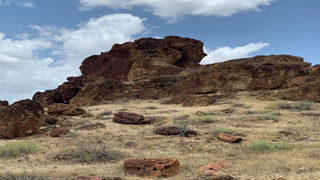
Sibiloi's petrified forest.
| jacob Walter | Nation Media GroupMarsabit
Premium
Welcome to Sibiloi, home to only petrified forest in East and Central Africa
In one of Kenya’s remotest national parks Sibiloi, in Marsabit County, is a hidden gem.
Here on the rugged shores of Lake Turkana lies a petrified forest, the remains of a once-great cedar forest, which covered the lake’s shores about four million years ago.
“Petrified Forest” gets its name from the trees that have, over millions of years, turned to stone. That natural process is called fossilisation.
In this park, fossilised logs lie scattered. Nature produced the mineralised wood under very special circumstances.
The trees were uprooted by great floods or perhaps flows of lava, then washed down from the highlands and buried by silt and volcanic ash.
Water seeping through the wood replaced decaying organic material cell by cell with multi-coloured silica.

A petrified log at Sibiloi National Park in Marsabit County.
Geological upheaval
Eventually, the land where the great logs were buried was lifted up by geological upheaval, and wind and rain began to wear away the overlying sediments, finally exposing the long-buried, now petrified wood.
Each piece of wood is unique, burning with the colours of the Painted Desert, of which Petrified Forest National Park is a part.
Some of the great trunks still bear the annual rings that reveal their life histories in prehistoric times.
The history of the Petrified Forest area goes back more than 4 million years.
Sibiloi National Park is a World Heritage site recognized by Unesco and also famed for being the cradle of humankind due to its thousands of unique fossils and archaeological worth.
Although the park might be limited and far-flung as compared to other safari destinations in Kenya, it still stands as one of the most auspicious and stunning places in Kenya.

Tourists view petrified logs Sibiloi National Park in Marsabit County.
Artist’s canvas
The park looks like an artist’s canvas. Brilliantly coloured mudstones and clays cover the land as far as the eye can see.
They contain bentonite, a clay that is the product of changed volcanic ash.
According to the Kenya Wildlife Service Northern Kenya Conservation Area Deputy Director Robert Obrien, Sibiloi National Park was legally designated as a national park in 1973 whereas South and Central Islands were legally designated in 1983 and 1985 respectively.
“Sibiloi National Park is the home to the only Petrified Forest in East and Central Africa and it is a site teeming with a lot of prehistoric discoveries,” Mr Obrien said.
The property is co-managed by KWS and the National Museums of Kenya (NMK).
It enjoys the highest level of legal protection by both the Kenya Wildlife Act cap 376 as well as the Antiquities and Monument Act cap 215 (currently the National Museums and Heritage Act of 2006) under Kenyan legislation.
This remarkable park was established by the Government of Kenya for the protection of wildlife and palaeontologist sites there.
It covers 1,570 square kilometres and is internationally known for its fossils.
Sibiloi is also home to important archaeological sites including Koobi Fora where the fossil remains have contributed more to the understanding of human evolution than any other site on the continent.
Semi-desert habitat
The zone is considered a semi-desert habitat and open plains skirted by volcanic formations, including Mount Sibiloi, where the remains of a petrified forest can be seen.
The park was originally named after Mount Sibiloi which is located near the park headquarters of the Kenya Wildlife Service.
The park's climate is hot, nonetheless, it still protects a range of wildlife that can live in arid conditions such as Grévy's Zebra, Gerenuk, Beisa Oryx, and Greater Kudu.
Other wildlife species include predators like the lion, leopard, cheetah, striped and spotted hyena, jackal and caracal.
You can also spot a variety of water birds on the shoreline including African Skimmers, Herons and Gulls. Last but not least, the park is home to local species such as the Crested Lark and Heuglin's Bustard.
The world’s largest population of Nile crocodile is found on the north, south and central islands of Lake Turkana, making the location very unique.
With more than 300 bird species recorded around Lake Turkana, birdlife is prolific.
The number increases during the summer months due to the migration of species.
As the park’s name indicates, however, its foremost fossils are petrified logs.
It became a protected national site when archaeological digs started in the late fifties.
Skulls found
Over 200 separate hominids and animal skulls have been found here, and the site has yielded more fossils than any other single place in the world.
According to Marsabit County Documentation Officer Rehman Moghal, extensive finds have been made in the area since 1969, including the discovery of Paranthropus Boisei, a human species.
He said that the discoveries have been key in understanding the evolutionary history of the human species too.
The most preferable time to visit the park is in March, during the crocodile breeding and birds’ migration back to Europe. Other than that, the park can be visited during any time of the year, given the climatic conditions.
According to Marsabit County Tourism and Culture Director Abdullahi Ibrahim, visitation to the park is not frequent due to minimal accessibility except for archaeologists and lack of publicity.
He bemoaned that little is known about the Petrified Forest due to its remoteness, poor roads leading to the place and lack of publicity.
He called on the Kenya Tourism Board to research extensively, share the reports about the site and feature it in their websites.
“Thousands of hundreds of non-hominids and hominid species have been discovered in Koobi Fora more than any other place globally, but very little is known about the Petrified Forest in Sibiloi National Park,” Mr Ibrahim said.





